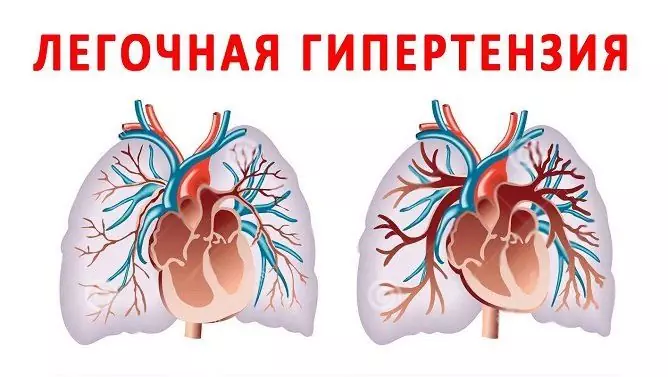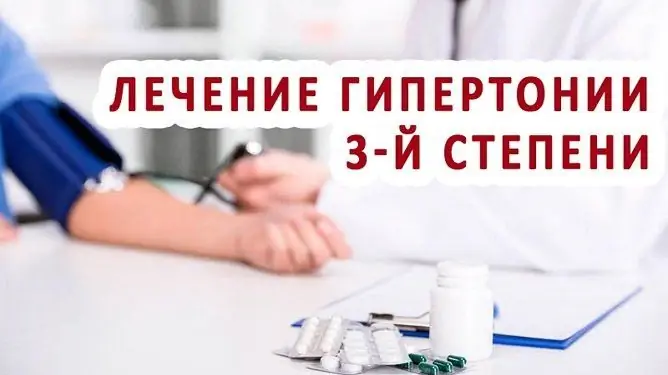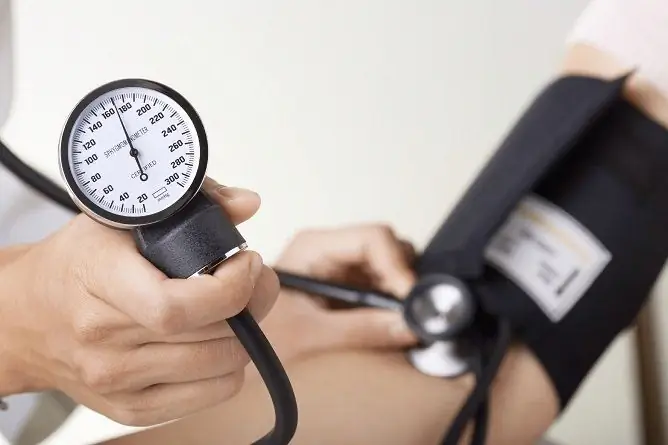- Author Rachel Wainwright [email protected].
- Public 2023-12-15 07:39.
- Last modified 2025-11-02 20:14.
Hypertension grade 2: risk 2, 3 and 4
The content of the article:
- What is it - grade 2 hypertension
- Stages of hypertension
- Pathology hazard levels
- Causes of occurrence
- Symptoms of hypertension of the second degree
- Diagnostics
- Treatment
- Consequences and disability
- Video
Hypertension of the 2nd degree is characterized by an increase in blood pressure up to 160-179 per 100-109 mm Hg. Art. If such numbers persist for a long time, while the patient is not provided with the necessary medical care or is provided incorrectly, the disease progresses, and dangerous complications may also arise.

Second-degree hypertension is diagnosed by blood pressure indicators - 160-179 / 100-109 mm Hg. Art.
What is it - grade 2 hypertension
Essential hypertension is characterized by persistent arterial hypertension, i.e., an increase in blood pressure over 130/80 mm Hg. Art. Depending on the level of excess of the norm, the degree of the disease is determined. The pathology proceeds chronically, for many months or even years. In such a long-term dynamics, it is difficult to notice the progression of the disease, but it happens - slowly but surely, the compensatory forces of the body are depleted, and the disease moves on to the next stage.
Grade 2 means that the pressure fluctuates in the range of 160-179 mm Hg. Art. for upper, systolic pressure, and 100-109 mm Hg. Art. diastolic. These are quite high numbers, so this diagnosis requires the prevention of hypertensive crises, lifestyle correction, regular blood pressure monitoring and drug therapy.
Stages of hypertension
Depending on the damage to the internal organs with the highest blood circulation (the so-called target organs or shock organs, which need constant and uninterrupted nutrition more than others), three stages of the disease are distinguished:
- Stage 1 - the patient's state of health is normal, high blood pressure is recorded, but no lesions of internal organs and systems were found, as well as their functional failure;
- Stage 2 - there are pathological changes in the stroma and parenchyma of internal organs, the process of degeneration of shock organs begins - kidneys, liver, heart and brain. On the macro specimen, hemorrhages into organs are visible, their functional effectiveness decreases. The second stage is characterized by noncritical damage to one or more target organs;
- Stage 3 - there are severe complications from the shock organs, their parenchyma suffers, foci of necrosis appear, which are replaced by connective tissue. Signs of dysfunction from different systems - brain, heart, visual analyzer. The patient's state of health is deteriorating, there is a high risk of complicated hypertensive crises. The patient at this stage is obliged to regularly take medications to maintain normal life.
Hypertension of the second degree can be at any of the stages.
Pathology hazard levels
There are several levels of risk for the disease. They determine how high the likelihood of complications, as well as how far the changes in important organs have gone, and thereby help to develop adequate treatment tactics.
Risk 1 means that the likelihood of complications is low, less than 15%. Changes in shock organs are minimal or do not appear at all. There are no chronic diseases and other factors that can negatively affect the course of the disease and complicate its treatment.
The risk of 2 grade 2 hypertension is associated with the presence of at least three risk factors, such as smoking, obesity, a sedentary lifestyle, and diabetes mellitus. Internal organs suffer. The changes also affect the blood system - after making an analysis, it is possible to determine in the blood markers of damage to certain organs. There is a distinct symptomatology characteristic of arterial hypertension.
Risk of 3 grade 2 hypertension - this condition is widespread in older people. This is due to the loss of elasticity in the walls of the blood vessels. The course of the disease is complicated by other chronic pathologies, for example, ischemic heart disease, which is summed up by its negative effects with dilatation or compensatory hypertrophy of the heart. Impaired blood flow affects all body functions.
Risk 4, the most severe, is associated with experienced exacerbations of diseases or long-term chronic pathologies, usually reflected in the patient's medical history. This degree of risk is typical for patients with atherosclerosis of the vessels at the stage of plaque and obstruction of the lumen, after myocardial infarction, stroke or transient ischemic attack. Risk 4 requires regular check-ups and medication.
Causes of occurrence
Essential hypertension is a multifactorial disease, one clear cause of which cannot be established; its pathogenesis affects many systems. However, it is known that the main mechanism of increasing pressure is the formation of a vicious circle associated with an increase in the concentration of renin in the blood, secreted by the kidneys. Renin in the lungs is converted into angiotensin I, and then into angiotensin II - one of the strongest vasoconstrictors (i.e., vasoconstrictor substances) of biological origin in the human body. It stimulates the secretion of aldosterone, affects the secretion of vasopressin and fluid retention. The final stage is the swelling of the vascular endothelium, where sodium ions and water rushed.
Since the root cause of such a cascade of reactions, as a rule, cannot be identified, risk factors were identified that affect the risk of pathology. These include:
- smoking - components of tobacco smoke cause not only local irritation of the bronchial tree, but also a strong vasospasm. This leads to ischemia, which is especially dangerous for the brain and peripheral vessels. Constant spasms (many times a day) disrupt the work of the vasomotor center, and the vessels compensate for the cardiac impulse worse;
- obesity - excess body weight is visible not only from the outside, fat deposits are also found inside the body. The cardiovascular system does not cope well with the volume of blood that needs to be pumped through the microvessels in the adipose tissue, and experiences constant overload;
- cholesterolemia - high cholesterol in the blood leads to the formation of fatty spots and lines, and then plaque. The plaque violates the integrity of the vascular wall, causes a narrowing of the vessel lumen, locally increases the pressure in the vascular bed;
- diabetes mellitus - disrupts all types of metabolism, therefore, adversely affects the energy supply of the heart muscle, as well as the utilization of cholesterol and other substances affecting blood pressure;
- age and gender - the older a person is, the less elastic his vessels are, and the worse they withstand a heart beat without pressure surges. Women have natural defenses in the form of estrogen - it significantly lowers blood pressure, so they often have hypertension after menopause, when estrogen production drops sharply. Men develop hypertension at an earlier age, because their vessels do not have hormonal protection;
- genetic predisposition - more than 20 genes have been discovered that are in one way or another associated with increased blood pressure and pathology of the cardiovascular system. If a blood relative has hypertension, the chances of getting sick are significantly increased.
Symptoms of hypertension of the second degree
The manifestations of the disease depend on those organs and systems that suffer from high blood pressure and insufficient blood flow. Allocate cardiac, cerebral (cerebral), renal, and symptoms associated with retinal damage. However, the main one is increased to 160-179 / 100-109 mm Hg. Art. HELL.

With grade 2 hypertension, cardiac symptoms appear, in particular, chest pain
Cardiac symptoms include shortness of breath, palpitations, arrhythmias, weakness and anxiety, a feeling of tightness in the chest, chest pain, and occasionally an unproductive cough.
Cerebral: persistent headache, sleep disturbances, dizziness, tinnitus, nausea (during a crisis - until vomiting). Possible decrease in memory, performance, apathy, low physical activity, fatigue.
With kidney damage, dysuria is observed (too frequent or, on the contrary, rare urination, nocturia), changes in the composition and appearance of urine, renal edema (soft, warm, observed in the morning after a night's sleep).
Damage to the retina is characterized by decreased vision, flashing flies or the appearance of fog before the eyes, darkening in the eyes.
Diagnostics
During the examination, the doctor adheres to a certain algorithm. Diagnostics begins with the collection of anamnesis and an objective examination of the patient, after which the pressure is measured three times alternately on both hands, and its average value is determined. After that, the patient is sent for a clarifying examination diagnosis - ECG and ultrasound of the heart to determine dilatation or hypertrophy, examination of the fundus for the presence of altered vessels and damage to the optic nerve head.
Laboratory tests include a general analysis of blood and urine, a biochemical blood test, determination of the concentration of free cholesterol, determination of the glomerular filtration rate, creatinine clearance.
Treatment
Grade 2 hypertension usually requires drug therapy.
The following groups of drugs are used:
- diuretics - remove fluid from the body, reduce the volume of circulating blood, relieve edema, regulate water-salt metabolism. Their use is carried out strictly under medical supervision, since there is a risk of developing electrolyte metabolism disorders. This group includes Furosemide, Lasix, Mannitol, Veroshpiron, Hypothiazide, Indapamide;
- ACE blockers - prevent the conversion of renin into angiotensin, thereby breaking the pathogenetic chain of hypertension. Effective drugs in this group are Captopril, Lisinopril, Hartil;
- beta-blockers - bind to beta-adrenergic receptors and block them, thereby normalizing the contractile activity of the heart, causing vascular relaxation. In addition to the hypotensive effect, they have the ability to eliminate arrhythmia and normalize the cardiac cycle. This group includes Atenolol, Bisoprolol, Nebivolol;
- calcium antagonists - smooth muscle elements in the vascular wall contract due to interaction with calcium ions. Drugs that block calcium channels and are its antagonists prevent the contraction of blood vessels, narrowing of their lumen and an increase in pressure. These are Nifedipine, Amlodipine, Verapamil;
- additional group drugs - drugs that act on the central nervous system, sedatives, sedatives, tranquilizers, and others.
In addition, there are many combination drugs for lowering blood pressure, which include several active ingredients, providing a complex effect.
An important condition for the effectiveness of treatment is lifestyle modification - elimination of physical inactivity, rejection of bad habits, excessive physical and mental stress, normalization of work and rest, healthy diet with limited salt intake.
Consequences and disability
The consequences of hypertension can be quite serious if not treated on time. Organ damage is more common at grade 3, but it can also occur at grade 2 during hypertensive crises, especially complicated ones.

If left untreated, hypertension can have dangerous consequences
Perhaps the development of coronary heart disease, which sooner or later will lead to myocardial infarction, the development of acute or chronic heart failure, acute cerebrovascular accident (stroke), the development of renal, hepatic, respiratory failure, the appearance of an aortic aneurysm or other large artery, its rupture.
With hypertension of the 2nd degree with a high risk, you can get a disability, this is decided by a special commission based on the study of the documents provided by the attending physician.
Video
We offer for viewing a video on the topic of the article.

Nikita Gaidukov About the author
Education: 4th year student of the Faculty of Medicine No. 1, specializing in General Medicine, Vinnitsa National Medical University. N. I. Pirogov.
Work experience: Nurse of the cardiology department of the Tyachiv Regional Hospital No. 1, geneticist / molecular biologist in the Polymerase Chain Reaction Laboratory at VNMU named after N. I. Pirogov.
Found a mistake in the text? Select it and press Ctrl + Enter.






